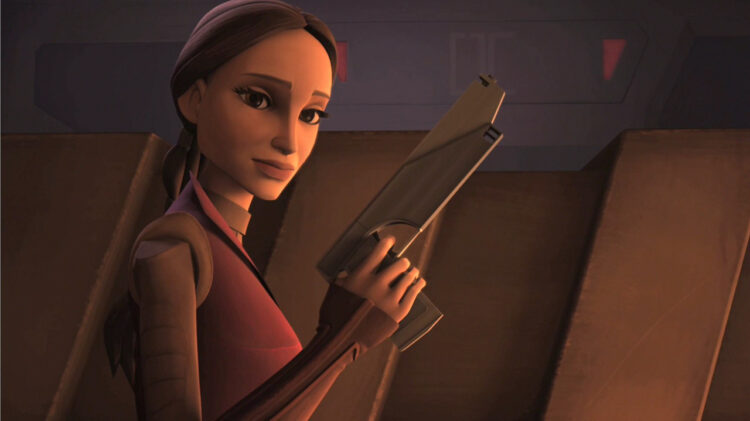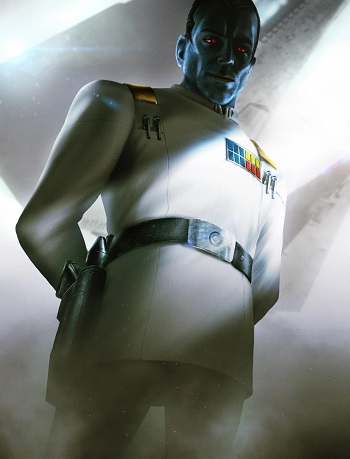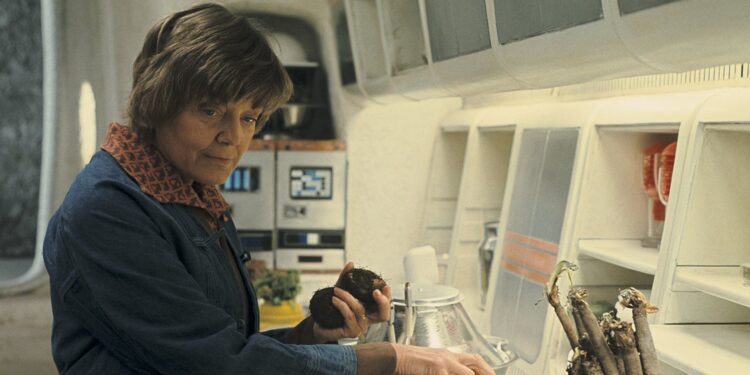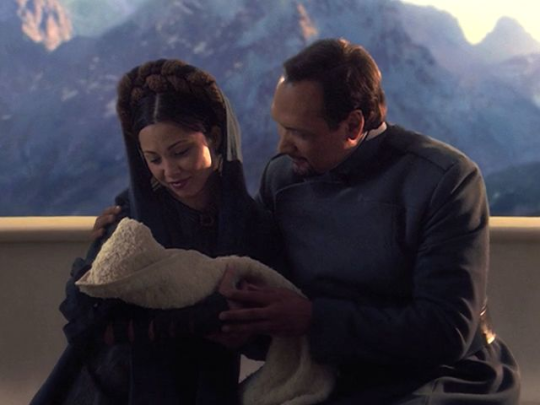The final section of this piece contains major spoilers for Queen’s Hope. There will be another warning immediately beforehand.
There’s something about Star Wars and threes. Queen’s Hope, which released yesterday, is the third young adult book about Padmé Amidala in as many years, and while I have no special reason to assume this will be the end of that particular line of stories, it feels likely, doesn’t it? If nothing else, E.K. Johnston is quickly approaching the end of Padmé’s life; having covered her transition from queen to senator and now from single to married, there isn’t much more of significance for her to write about beyond retreading the events of Revenge of the Sith—and even those the series already touched on briefly in the epilogue to Queen’s Shadow.
On top of that, there just isn’t much precedent for Star Wars doing four or five of something; even the perpetually-bestselling Thrawn books have always ended up resetting in one way or another after no more than three. While junior novel series are a common exception, you’d have to go back to Legends and the New Jedi Order for an example of adult novels telling a single linear narrative across more than three books—even the High Republic has broken its meta-arc, so far at least, into “phases” of three books per format.
On the other hand, “young adult” novels as they’re currently understood don’t have a lot of precedent in Star Wars to begin with. While they tend to be smaller in scope and more limited in their perspective than Del Rey’s novels, the modern Star Wars young adult line has displayed a range of quality and, er, maturity in its writing equal to and sometimes even surpassing Del Rey’s.
I’m hopeful, though, that the line can embrace its position “between” the adult and junior novels in one respect: by embracing the junior novels’ willingness to go long. It’s hard to say authoritatively how well the Queen’s books are selling compared to anything else, but given how quickly we got the first two follow-ups (even with a six-month delay this time around) it certainly seems like they’ve found an audience. And if it were up to me, E.K. Johnston would keep going for the foreseeable future—even if that means leaving Padmé behind.
But nothing happens in them
Not that leaving Padmé behind has to happen immediately. While the Clone Wars (and The Clone Wars) do a lot to box Padmé in and limit how many real wins she can negotiate—aggressively and otherwise—Queen’s Hope demonstrates that there are still stories than can be told in this era; especially by E.K. Johnston, whose strengths I would argue are a perfect match for the character and her in-universe limitations.
I have to admit that I actually found Johnston’s Star Wars debut Ahsoka to be a bit underwhelming; her action scenes tend to feel understated by Star Wars standards, like they’re being summarized rather than experienced by the character in question—and for a Force-powered protagonist like Ahsoka that was enough to drag down the parts of the book I liked more. The Queen’s books still feature moments of action, but in a way that’s almost unique among Star Wars content, the blasting and running and mortal peril are the seasoning rather than the main course.

While she’s always willing to shoot a guy, Padmé is first and foremost a politician, and a young woman, and I find it very refreshing that this series has been given the freedom to focus on what Johnston does best—the interpersonal evolutions and upheavals of a group of close friends during a time of extreme political change—rather than try to stretch Padmé’s life to fit all four corners of a mainstream Star Wars story. Space legislation and the tribulations of a bunch of former handmaidens may not be to everyone’s interest, but they’re part of what the story is already about, and no less appropriate for new content than military sci-fi, a mode in which Timothy Zahn has been allowed to operate almost nonstop for the last several years (and intermittently going back to 1991).
Who are they even for?
Book sales figures are notoriously opaque, and bestseller lists are arbitrary at the best of times, but in an attempt to apply some kind of real data to this question I looked up Johnston’s and Zahn’s respective current positions within their best-selling category on Amazon. As of this writing a few days before the release of Queen’s Hope, those three books in their various formats currently occupy numbers three and four (Hope), fifteen and twenty-five (Peril), and sixty-eight and seventy-five (Shadow) in the “Teen & Young Adult Space Opera” category. In Zahn’s best non-licensing-based[1]There’s actually a “Star Wars Series” category that Zahn is all over but it doesn’t seem to count the young adult books at all so I can’t compare them directly that … Continue readingcategory, “Space Fleet Science Fiction“, Thrawn Ascendancy: Lesser Evil is #241, Greater Good is #326, and Chaos Rising is #276.

Each of those categories is its own thing, of course—is Zahn selling more actual books than Johnston? That’s probably that’s a safe bet. But by the standards of their respective genres, as Amazon is choosing to define them, Johnston seems to be throwing a lot more weight around.[2]I wondered if perhaps there was a greater stigma against tie-in books among the military sci-fi readership so I looked up Pawn, a recent non-Star Wars book of Zahn’s, and it was #2,569. And as for direct comparisons, a slightly more apples-to-apples metric might be the books’ respective number of reviews—the three Thrawn Ascendancy books currently average out at 3,220 reviews each, which Queen’s Shadow narrowly beats at 3,298 while Peril (which came out a few months into the pandemic) drops down considerably to 1,376.[3]Incidentally, Queen’s Shadow also beats Lost Stars, the original and perhaps best-received Star Wars young adult book, which has 2,706 reviews. I would say this isn’t enough of a sample size to draw any huge conclusions (not to mention that reviews can be, y’know, negative) but it’s not the slam dunk you might expect, either.
Don’t get me wrong, this is pretty messy data—ultimately I don’t think we as fans can really say how well they’re selling, or more to the point, what the line would be between choosing to conclude a series and choosing to continue it. Forgoing the full spectrum of Star Wars in favor of focusing through a particular genre or topical lens may or may not limit a given book’s audience, but speaking from my own experience as a reader with literally hundreds of Star Wars books under my belt, I think the best possible thing the line can do to stay fresh is branch out. The trappings of Star Wars have proven to be an excellent sheen on all sorts of genres, and the more the books eschew the epic formula of the movies and just do their own thing, the more exciting I tend to find them—not because of the stakes, or the larger-than-life action, but simply because it’s something different. In the words of Phil Connors, anything different is good.
Stop reading here if you wish to avoid major spoilers for Queen’s Hope.
The story is done, though
If the books did continue, where would they even go from here? With a good fifth of Queen’s Hope taking place in the leadup to Anakin and Padmé’s wedding, Johnston has now at least touched on the events of all three prequels; what more is there for her to do beyond simply retelling Revenge of the Sith from Padmé’s point of view?
As it happens, Hope distinguishes itself most from its predecessors not for concluding their story, but for its new beginnings—which suggests Johnston has lots of places left to go. Padmé’s mission brings her into contact with a rogue element within Neimoidian society, one that seeks to depose Lott Dod and repair the Trade Federation’s reputation by more aggressively renouncing the Separatist cause. That effort cannot succeed, but what it could become, with more time, is a means for Padmé to come to terms with the Trade Federation and Naboo’s shared history, and to heal her own lingering resentment toward Neimoidians in general. Imagine that rogue element eventually becoming a Neimoidian contingent of the Rebel Alliance, working alongside Padmé’s old senatorial allies in her name—that’s a story still worth telling.
Or, for the sake of argument, let’s assume the series really is done with the prequel era. Padmé may be dead, but she leaves behind a versatile supporting cast headed up by Sabé—who’s arguably Hope‘s co-lead, in fact. While most of the other handmaidens from the earlier books have already faded into the background of the narrative, Hope takes steps to extend Johnston’s lens to the other underserved women of the prequel era, including, most interestingly, Beru Lars.

Beru, we learn, is now part of a group of Tatooine locals dedicated to freeing slaves. With Shmi Skywalker as her first test subject, Beru has developed a device capable of locating and disabling the explosive tracking chips introduced in The Phantom Menace and then never mentioned again. With the chips removed, Sabé and Tonra are then able to ferry the emancipated beings to new lives elsewhere—work we eventually learn the rogue Neimoidian is also engaged in, specifically as a means to demonstrate his good intentions to Padmé.
The slaves of Tatooine that Anakin never got around to freeing, at least to my mind, have been an open plot thread for a long time now. Not that long ago I had high hopes that The Book of Boba Fett was going to do something with this, but outside of one Twi’lek in that very first teaser scene a year ago, slavery doesn’t really come up. Owen and Beru, meanwhile, are set to appear in next month’s Obi-Wan Kenobi series but it seems pretty unlikely that this thread would be picked up there, if only because the modern screen content seems to prefer avoiding the subject.
For that matter, outside of Jabba’s palace the status of slavery on Tatooine during the original trilogy has never really been touched on. While nothing can save poor Oola from her fate, there could well be a story here—a practice that seemed pretty commonplace forty years earlier could potentially have become too costly now for average shlubs like Watto to participate in, or even have fallen sufficiently out of favor among the locals that only the mighty Jabba can still get away with it.
It’s a rare instance in this era where a victory of real significance could be won without conflicting with the larger story of the Empire—one that would demonstrate the strong moral core we already know the Lars family instilled in Luke Skywalker, letting them be more than just the people he longed to escape from. It’s not necessary, the story works as-is, but there’s real potential there. And it would give Sabé a mission she can actually accomplish over the next couple decades, until her story is eventually picked up by Greg Pak in the recent Darth Vader comics.

Of course, if the series did continue, it could use another queen to justify its title motif—and as it happens Johnston ends the story on the perfect person to carry Padmé’s banner forward another twenty years: Breha Organa. The final pages of Queen’s Hope sketch out the ways in which Alderaan, under Breha’s leadership, inspired the galaxy and served as a bulwark against the worst of the Empire; work that, like Padmé’s, would continue long after Breha was no longer around.
So perfectly do the Beru and Breha vignettes sketch out a possible future for the Queen’s series—with a new queen and everything—it’s almost as if E.K. Johnston intended them as just that: not brief digressions, but a to-do list. I hope she knows something I don’t.
| ↑1 | There’s actually a “Star Wars Series” category that Zahn is all over but it doesn’t seem to count the young adult books at all so I can’t compare them directly that way—see what I mean about arbitrary? |
|---|---|
| ↑2 | I wondered if perhaps there was a greater stigma against tie-in books among the military sci-fi readership so I looked up Pawn, a recent non-Star Wars book of Zahn’s, and it was #2,569. |
| ↑3 | Incidentally, Queen’s Shadow also beats Lost Stars, the original and perhaps best-received Star Wars young adult book, which has 2,706 reviews. |

